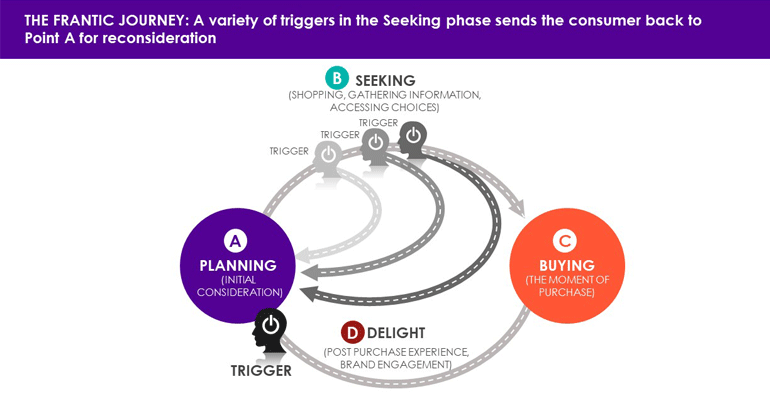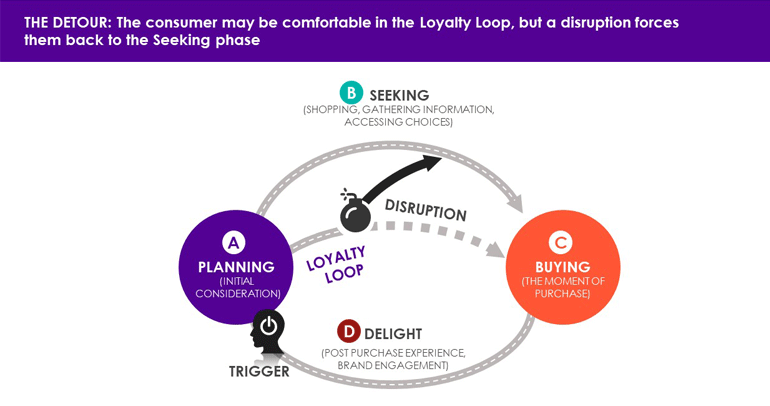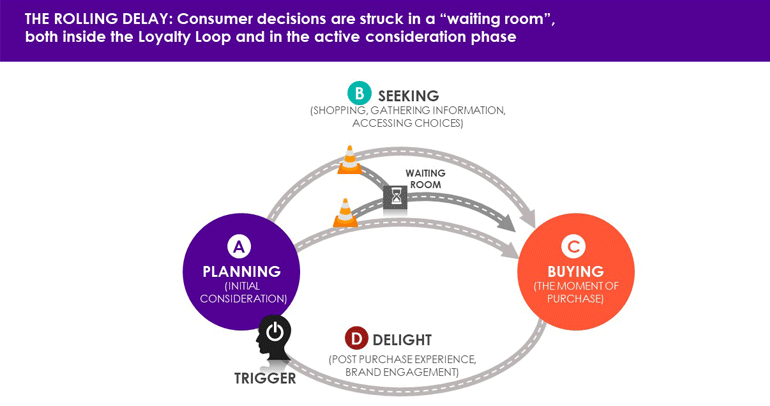
As the world continues to adapt to the evolving impact of the coronavirus, corporate executives face critical decisions on how to respond. The consumer path to purchase in the age of COVID-19 is adapting and responding too. Headlines like “Global Economy Crashes on Mass Virus Business Shutdowns” is grabbing everyone’s attention. This is just one example, courtesy of Bloomberg News. They can be found in virtually every media outlet. Heavy on sensationalism, light on solutions.
In broad strokes, we can all see the problem: manufacturing output is in decline, supply chains are disrupted, and services businesses are largely shuttered. Consumer spending—the heart of most mature economies—is plummeting. The headlines conjure images of consumers slinking to their caves to hibernate. The problem with this media narrative is that it too easily implies that it’s time for brands to go into hibernation as well.
But the truth is more complex. The consumer journey has not simply been unplugged. Instead, the traditional journey has morphed.

At Escalent, we are watching closely as three new paths to purchase emerge. We’re calling them 1) the Frantic Journey, 2) the Detour, and 3) the Rolling Delay.
This unprecedented moment of global disruption is impacting industries and geographies in distinct ways, at different speeds, and to varying degrees. The specific form your customer journey takes, or is about to take, may not match up precisely. But, as we work with clients around the globe, in a variety of industries, we’re seeing the following new paradigms emerge and advising them accordingly.
Consumer Journey 1: The Frantic Journey
It’s easy to conclude that people aren’t hurrying their decision-making around vacation time-shares, but there are some industries for which the current crisis actually accelerates the purchase journey and sends it into a perpetual loop. Take, most notably, the wealth management industry. As we saw in the 2008 financial crisis, a financial shock does not simply move investors out of the purchase journey. Rather, when investors are watching the markets every day (if not every hour), they become locked into a frantic, repeated purchase journey.
Every day that investors maintain the positions in their portfolio, they are actually making a decision not to sell. Every time they sell out of a position, they’re making a conscious decision about what to buy (even if it’s cash, in the form of a money market). Take the traditional consumer journey schematic and pepper it with dozens of triggers. These triggers take the form of everything from a casual conversation with a friend who’s just made a trade, to the chyrons on the news, to an anxiety-inducing brokerage statement in the mail, to an alert set in a personal finance app. And, because the post-purchase experience is no longer indicative of future experiences, the all-important “loyalty loop” becomes attenuated.

In times like these, wealth managers need insights to help define how investor goals are changing. Which asset classes are falling out of favor? How are information needs different than they were in a normal market? Right now, the pace of change is frantic and the decisions are fraught. Brands that operate in this space need to pay particular attention to their customer touchpoints. Building trust and minimizing decision friction is critical for retaining engagement.
Sectors Likely Affected by The Frantic Consumer Journey: Wealth Management, Asset Management, Personal Banking
Critical Needs: Sentiment Tracking, Messaging, Product Optimization Strategy
Consumer Journey 2: The Detour
Unlike prior economic shocks, a distinctive element of the coronavirus is a change in how we buy. While some elements of your insights agenda can be paused during the crisis, an understanding of channel dynamics may suddenly become essential.
“The Detour” is a consumer journey that takes the buyer on an alternate route that could end up permanently altering their buying decisions. This can happen in sectors where demand remains steady throughout the crisis, if not elevated. For example, take toilet paper. Consumers may want to make the same brand choices they have made in the past but the loyalty loop is disrupted by supply disruptions or channel inaccessibility. When there is no Charmin on the shelf, consumers may snatch up what’s available. Trial by scarcity might just change their brand preference.

These supply and channel disruptions elicit a number of critical questions. For manufacturers, where and how are consumers sourcing your products now? How are disruptions in typical supply chains affecting perceptions of your brand, creating opportunities for competitors, and potentially changing long-term decision journeys? Can you intervene to meet consumer demand? Or adapt your channel strategy in ways that create lasting benefits for your business?
The nature of this particular crisis is causing consumer journey detours for numerous industries. We are witnessing major shifts across brick-and-mortar, one-time e-commerce, and long-term web subscription services. Some of these shifts may be largely temporary, while other categories may make permanent gains. For example, Unilever’s leverdirect is offering bundled cleaning kits and free delivery, saving consumers a trip to the grocery store for their COVID cleaning essentials. Instacart’s hiring of 300,000 employees to accommodate the surge in grocery delivery may be temporary. It’s a response to the disruption in the normal shopper journey due to social distancing restrictions. But it is also a new way of buying that some consumers just might grow to like, and for some, it could become a long-term behavior.
Similar gains are being made by meal subscription services, like Blue Apron and HelloFresh. These businesses are working feverishly to understand how they can lock in part of these gains after the restaurants reopen. Other businesses, like Chewy, are showing customers that there never was an advantage to dragging home heavy bags of dog food from big box pet stores. It is possible they’ll see more permanent gains. And, for those businesses who had never focused on their online retail channel, we are witnessing a desperate scramble to catch up with a direct sales strategy.
Sectors Likely Affected by The Detour: CPG/FMCG, Retail, Restaurants.
Critical Needs: Path to Purchase, Consumer Journey Mapping, Analytics, Competitive Intelligence, UX Research
Consumer Journey 3: The Rolling Delay
For many categories, like durable goods or travel, consumer journeys may find themselves (literally and figuratively) on an indefinite hold. In essence, the path has been ruptured after the trigger, at some point during the evaluation phase. This may be the modal case during a downturn as severe as our current situation, compounded as it is by legal restrictions on activities outside the home. As companies in many sectors wait for their consumers to emerge from hibernation, stakeholders will feel like they’re trapped in an airport, watching their flight’s departure time get pushed back again and again.

It may not make sense for some of these brands to push forward with certain types of research and marketing activity just now. Rather, they should shift focus on preparedness for when the new buds break. Of late, we’ve seen a lot of advertising with pointed calls to action. TV ads for cruises ran as recently as last week. That ad spend is unlikely to move consumers in the midst of a public health crisis. While many businesses have good reason to be focused on their bottom line, this is a moment to focus more on long-term brand engagement than sales and product-focused messaging. For instance, Andrew Weil’s True Food Kitchen is generating more long-term value for the business by publishing easy-to-execute home recipes than by flogging messages to order take-out. Uber is wise to focus on its pledge to provide 10 million free rides and meal deliveries to displaced workers. The brand is building a sense of community and brand engagement at a moment when it knows paid rides will be at a low ebb. Savvy brand management now will yield outsized dividends when our global fever breaks.
And, when it does break, some categories will experience a rush of new business, creating more opportunities for disruption. We know from past recessions that consumers tend to reward themselves as they emerge from periods of austerity—what pundits sometimes call “revenge spending.” We’ve already seen some evidence of revenge spending in China, as restrictions ease. The key is to prepare for that moment: what’s the right product configuration, the right promotion, the right messaging strategy to win a disproportionate share of that renaissance?
The renaissance is coming. Here at Escalent, we’re focused on being Bloomsday preppers.
Sectors Likely Affected By The Rolling Delay: Travel & Tourism, Luxury Brands, Automotive and markets that are further along the pandemic lifecycle, like China
Critical Needs: Branding, Messaging, Sentiment Tracking
We hope that by identifying how purchase decisions are morphing to fit our new reality, brands can take the right actions to meet the future. When we emerge from this crisis —and we will, understanding the nuances of consumers’ changing behaviors will be essential to how businesses fare, now and for the long haul.
Escalent can help you map your new path to purchase and identify strategies for success in these unprecedented times. Let’s talk!








